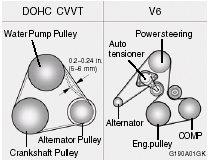Air cnditioning care
Keeping the Condenser Clean
The air conditioning condenser (and engine radiator) should be checked periodically for accumulation of dirt, dead insects, leaves, etc.
These can interfere with maximum cooling efficiency.
When removing such accumulations, brush or hose them away carefully to avoid bending the cooling fans.
Checking the Air Conditioning Operation
1. Start the engine and let it run at a fast idle for several minutes with the air conditioning set at the maximum cold setting.
2. If the air coming out of the in-dash vents is not cold, have the air conditioning system inspected by your Hyundai dealer.
CAUTION:
Running the air conditioning system for
extended periods of time with a low refrigerant
level may damage the compressor.
Lubrication
To lubricate the compressor and the seals in the system, the air conditioning should be run for at least 10 minutes each week. This is particularly important during cool weather when the air conditioning system is not otherwise in use.

Checking the Compressor Drive Belt
When the air conditioning is being used regularly, the compressor drive belt tension should be checked at least once a month with the engine turned off.
To check the drive belt tension, press down on the belt halfway between the engine crankshaft and compressor pulleys. Pressing with your finger, you should not be able to deflect this belt anymore than 1/3 of an inch. If the belt is too loose, have it adjusted by your Hyundai dealer.
See also:
Running costs
The new Hyundai Santa Fe proves that exceptional performance and a high
specification need not come at the expense of running costs or a sky-high
purchase price. Despite the improvements in equipm ...
Additional safety precautions
• Never let passengers ride in the cargo area or on top of a foldeddown back
seat. All occupants should sit upright, fully back in their seats with their seat
belts on and their feet on the floor. ...
Lighting control
The light switch has a Headlight and a Parking light position.
To operate the lights, turn the knob at the end of the control lever to one of
the following positions:
(1) OFF position
(2) Parki ...


